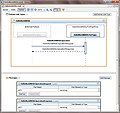|
OpenESB
OpenESB is a Java-based open-source enterprise service bus. It can be used as a platform for both enterprise application integration and service-oriented architecture. OpenESB allows developers to integrate legacy systems, external and internal partners and new development in business processes. It supports a multitude of integration technologies including standard JBI (Java Business Integration), XML with support for XML Schemas, WSDL, and BPEL with the aim of simplicity, efficiency, long-term durability, and low TCO (Total Cost of Ownership). It used to be owned by Sun Microsystems, but after Oracle and Sun Microsystems merged (see: Sun acquisition by Oracle), the OpenESB Community was created to maintain, improve, promote and support OpenESB.[citation needed] ArchitectureOpenESB consists of 5 parts: the framework, the container, the components, the Integrated Development Environment and the development plugins.
FrameworkThe framework consists of a lightweight JBI implementation in Java. This implementation is container-agnostic and can work on any platform and any container. Even if development and support are mainly focused on Glassfish V2 and V3 platforms, beta projects on JBoss and standalone JVM work well and are in progress (2012 Q2). In addition to the OpenESB framework being lightweight, it is also reliable and highly scalable. It is embedded in a Java virtual machine and communicates with other framework instances through Binding components. This architecture matches perfectly with new cloud architectures and allows easy deployment and management on very complex infrastructures. The framework is fully manageable with any JMX-based tool such as Jconsole or more sophisticated tools like Opsview or Nagios. The framework implements a virtual bus known as the Normalised Message Router (NMR). This is a powerful asynchronous intelligent communication channel between components. ComponentsThe JBI specification defines 2 component types: The services engine (SE) and the binding component (BC). The SE and BC implement the same interface contract, however, they behave differently: - Binding components act as the interface between the outside world and the bus, being able to generate bus messages upon receipt of stimuli from an external source, or generate an external action/interaction in response to a message received from the bus. - Service engines receive messages from the bus and send messages to the bus. SE's have no direct contact with the outside world. They rely on the bus for interaction with other components, whether binding components or other service engines. OpenESB includes many Components 'out of the box'. OpenESB Binding Components
OpenESB Service Engines
Integrated Development Environment & PluginsOpenESB offers a set of graphical tools to ease complex SOA and integration developments. Powerful XLM, XML Schema, WSDL, BPEL editor, data mapping and Composition Applications graphical editors are proposed with OpenESB. Similarly, build, deploy, un-deploy, run, test and debug tasks are managed by graphical tools. OpenESB provides the best ergonomics for ESB and SOA developments.
ContainerOpenESB V3.1.2 does not use any container but just a JVM. So, its memory footprint is very low (less than 300 Mo) and allows OpenESB to run in a Raspberry PI or in a many instances on a cloud. Next versions are planned for 2019. OpenESB communityThe table below lists the web sites and forum managed by OpenESB community
See also
ReferencesExternal links
|






